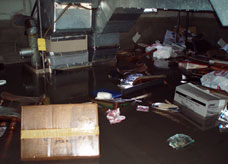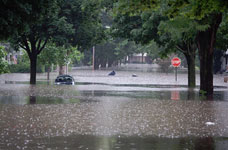 Just a small amount of water can turn a functional basement into a flooded nightmare. For furnaces located below ground level, contact with water can ruin circuit boards and other sensitive components. The resulting damage from a flood is usually dependant on the depth of the water and the duration of the exposure. In many instances, the damage is so severe that replacement is the only viable option.
Just a small amount of water can turn a functional basement into a flooded nightmare. For furnaces located below ground level, contact with water can ruin circuit boards and other sensitive components. The resulting damage from a flood is usually dependant on the depth of the water and the duration of the exposure. In many instances, the damage is so severe that replacement is the only viable option.
If there is a flood in your basement here are a few steps that should be taken to ensure the safety of your family. If your home happens to be prone to floods, we also outline some steps that can taken to ensure your furnace will run smoothly for years to come.
All electrical power should be disconnected to the furnace if a potential flooding situation exists. The gas line to the unit should also be turned off. Any furnace or water heater that has become wet should be inspected and tested by a qualified HVAC professional before turning it back on.
If the appliance has been cleared for use, it is important to immediately change the filter before engaging the unit. Wet filters will promote the growth of mold and fungi, which can degrade air quality in the entire building.

Flood-damaged furnaces are normally replaced instead of repaired. Natural gas furnaces contain a number of valves and other controls that are susceptible to failure when exposed to water. While the valve may appear functional, the interior of the unit may begin to rust without showing any obvious signs of damage. Faulty valves will affect the performance of the unit and may create future reliability issues.
If the controls, burners or other critical components have been underwater, dirt, sediment and other agents will eventually corrode the furnace. It is impractical to disassemble and clean the controls, so the long-term effect of water exposure will not be known until the furnace becomes operational.
While some flooded furnaces can be rebuilt, most manufacturers do not authorize the practice. In many instances, the liability associated with restoring a flood-damaged furnace is far greater than any potential savings from salvaging the equipment.
In homes prone to flooding, it may be worth the expense to move the furnace to an upper level or the attic. As an alternative, a concrete or masonry floodwall can be constructed around the appliance. When considering a furnace relocation or flood-proofing project, it is important to keep the following tips in mind:
[ebook]
A flooded basement is frustrating and time consuming to deal with. Since the safety and well being of your family is the highest priority, err on the side of caution when deciding how to address a flood-damaged furnace. In most instances, it makes more sense to upgrade the unit for superior comfort, efficiency and peace of mind.
The experts at Appleby Systems can help you choose the right solution for your home or help you deal with other damaged HVAC appliances or water heaters, Contact us today.
Photo credits to
Massachusetts Dept. of Environmental Protection under cc 2.0
U.S. Geological Survey under cc 2.0
